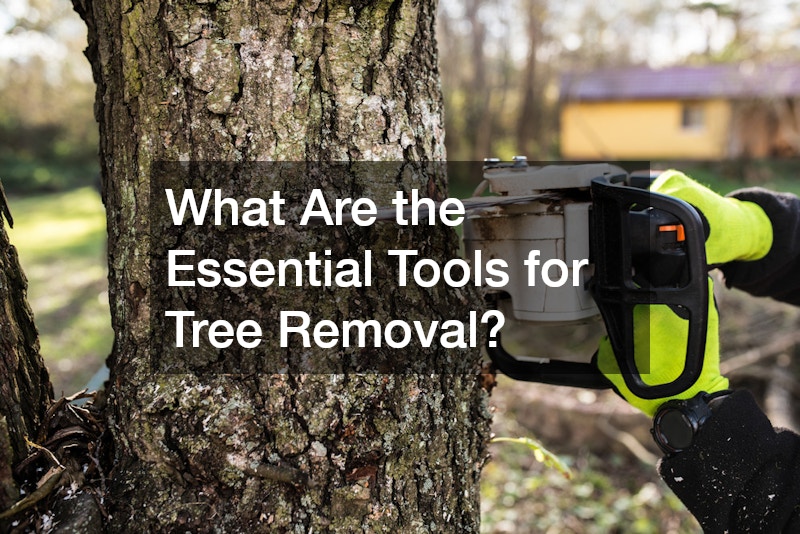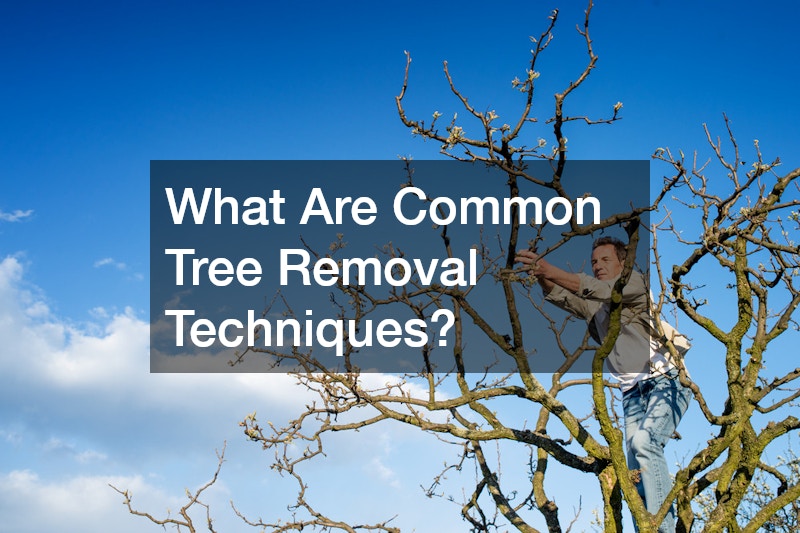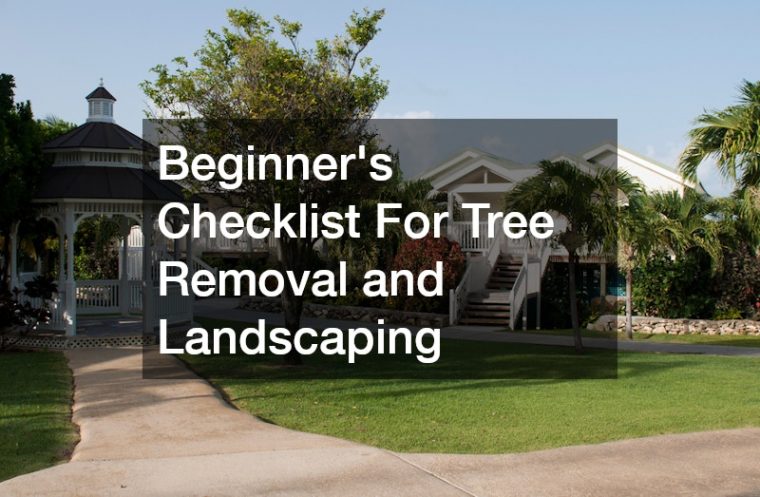
This comprehensive guide will teach you about tree removal and landscaping, essential for beginners looking to transform their outdoor space. Whether you’re motivated by aesthetics or necessity, understanding the intricacies of tree removal and landscaping will help you make informed decisions. We will address common questions, provide detailed information, and offer practical tips to ensure your project succeeds.
Tree removal and landscaping are critical aspects of maintaining a safe and visually appealing yard. While removing a tree might seem straightforward, several factors, such as permits, safety precautions, and the potential impact on surrounding plants, must be considered. Cutting down a tree without proper planning can lead to property damage, injury, or disruption to the local ecosystem. Similarly, landscaping requires strategic thinking to create a cohesive and sustainable design that enhances your property’s value and functionality.
Before starting, it’s important to assess the condition of the tree you plan to remove. Dead, diseased, or structurally unstable trees can pose hazards during storms or high winds, making their removal a priority. However, some trees may be protected by local regulations, requiring homeowners to seek approval before proceeding. Understanding these legal requirements will save you time, money, and potential fines.
Once the tree is removed, the next challenge is handling the remaining stump and roots. Grinding the stump is a common method to prevent regrowth and eliminate tripping hazards. Additionally, properly disposing of tree debris, such as branches and leaves, is essential for maintaining a tidy yard and preventing pest infestations.
Landscaping after tree removal opens up new opportunities for reimagining your outdoor space. Whether you want to plant new trees, install a garden, or create a patio area, planning is key. Choosing the right plants, considering soil conditions, and incorporating hardscaping elements will help achieve a balanced and long-lasting design.
By following this beginner’s checklist, you can confidently approach tree removal and landscaping with a clear plan. With careful preparation, adherence to safety guidelines, and an understanding of your property’s unique needs, you’ll be well on your way to enhancing your outdoor space efficiently and effectively.
What Are the Essential Tools for Tree Removal?

Proper tools are crucial for effective tree removal and landscaping. Essential tools include a chainsaw for cutting through thicker branches and trunks, pruners for smaller branches and twigs, and an axe for tackling robust roots. Each of these tools serves a specific purpose, ensuring that the tree removal process is efficient and safe.
For large-scale tree removal and landscaping projects, having tools such as a helmet, protective eyewear, and gloves is vital for personal safety. A ladder and climbing ropes might also be necessary for taller trees, alongside wedges to control the direction of falling trees. Combining protective gear with the right equipment helps maintain safety during the process.
Other supplementary tools such as wheelbarrows for transporting debris, chains or cables for pulling and securing, and shovels for clean-up post-removal add to the efficiency of tree removal. The proper usage of these tools makes the task easier and supports the overall objectives of tree removal and landscaping.
How to Assess Tree Health Before Removal?
Knowing the health of a tree before executing tree removal and landscaping is a vital step that cannot be overlooked. Inspect the tree for signs of disease, such as abnormal leaf shedding, discolored bark, or the presence of pests, which indicate poor tree health. These symptoms will help you decide whether full removal or just trimming is needed.
Consulting tree companies or professional arborists is advisable to conduct a thorough health assessment of your trees. They provide insights on potential disease treatments and the best course of action regarding tree health assessment and eventual removal, ensuring it aligns with your tree removal and landscaping goals.
A proper assessment can also reveal structural weaknesses, such as leaning trunks or split branches, which may pose safety hazards. Once you confirm the need for tree removal or tree service, a detailed understanding of tree health ensures your landscaping endeavors are both safe and efficient.
What Are the Permits and Regulations for Tree Removal?
Navigating permits and regulations is essential for a successful tree removal and landscaping project. Municipalities often have specific rules requiring permission for the removal of trees, especially if they are protected species or in a certain locality. Before proceeding with tree removal, conduct thorough research on any local laws that may apply.
Tree trimming services and other professional tree companies usually possess in-depth knowledge about the required permits and regulations. They handle the intricate bureaucratic process, ensuring that all legal requirements are met, which is crucial for any tree removal and landscaping project.
Failing to secure proper permits might result in fines or the forced cessation of your project. Engaging with experts ensures compliance with tree removal and landscaping regulations, allowing you to focus on transforming your outdoor space without legal impediments.
What Are Common Tree Removal Techniques?

Understanding various tree removal techniques broadens your insights and effectiveness in tree removal and landscaping. Standard techniques include directional felling, where the tree is cut to fall in a predetermined direction, usually away from obstacles or critical points in the landscape. This technique requires precision to avoid property damage or injury.
Arborists often employ rigging techniques for complicated tree removals, particularly in limited spaces. These methods involve cutting trees piece by piece and lowering them using ropes, preserving the surrounding landscape, and ensuring optimal safety. Rigged removals underscore the skills of tree teams and play a crucial role in detailed tree removal and landscaping efforts.
Another common method involves using cranes for large or hazardous trees, a specialized technique usually overseen by professional tree services. This method is recommended when traditional techniques pose too great a risk and ensures that the tree removal and landscaping process supports overall safety and project objectives.
How to Prepare the Landscape for New Landuses?
After successfully removing trees, preparing the landscape for new use is a vital step in your tree removal and landscaping journey. Begin by clearing any wood, debris, or remnants with tools like shovels, axes, or chainsaws. An efficient clean-up paves the way for the uninterrupted transformation of your landscape.
Consider the soil quality and make necessary amendments using organic materials or fertilizers, ensuring the ground is conducive for new plantings or structures. Taking such measures into account helps ensure that your tree removal and landscaping efforts bear the desired fruit, literally and figuratively.
Achieving compatibility with your envisioned landscape often involves leveling or terracing the ground, followed by strategic placement of new plant species or surfaces. Such planned efforts support your broader landscaping goals and make the most of the space post-tree removal.
What Are the Best Practices for Landscaping Design?
Effective landscaping design is an essential component of tree removal and landscape efforts. Start by drafting a plan that incorporates both aesthetics and functionality, keeping your budget and resources in mind. As you craft this plan, consider long-term factors such as growth patterns and seasonal changes.
Integrating wood waste recycling practices supports an environmentally friendly approach, turning debris into mulch or compost, adding value to your outdoor space. Not only does this help reduce waste, but it also enriches the soil, a win-win for tree removal and landscaping goals.
Utilize features such as water elements or stone pathways to add dimension and appeal to your landscaping design. Collaborate with tree service experts if needed, ensuring that project execution aligns with design intentions, creating a splendid outdoor zone post-tree removal.
How to Maintain a Landscaped Area?

Maintaining a newly landscaped area ensures the longevity of your tree removal and landscaping project. Consistent pruning, watering, and fertilization are foundational practices that prevent overgrowth and promote plant health. Scheduling regular maintenance routines guarantees that your outdoor spaces remain pristine and appealing.
Dumpster rentals can be incredibly useful for disposing of garden refuse very efficiently. They provide a convenient way to handle waste, ensuring your landscaping project is not only beautiful but clean and organized. Partnering with garbage collection services can streamline this process.
Keeping pest management strategies in place prevents unwanted damage to your plantings. Establish relationships with professional tree trimming service providers, who can provide customized guidance on pest control and specialized interventions to support continued landscaping excellence.
What Are the Cost Considerations for Tree Removal?
Budgeting is an important aspect of tree removal and landscaping projects. Costs encompass labor, equipment rentals, permits, and unexpected expenses. Obtaining multiple quotes from tree companies ensures you receive fair pricing and quality service for your tree removal needs.
Usage of resources like local lumber yards can help reduce costs by providing affordable materials and expert advice. Balancing cost-efficiency with quality enables the successful completion of tree removal within budget constraints.
It’s vital to account for potential post-removal landscaping expenses such as new plants, structures, or maintenance services. Effective financial planning helps maintain project feasibility, aligning tree removal and landscaping goals with available resources.
How to Select a Tree Removal Service?
Choosing a reliable tree removal service is crucial in executing your tree removal and landscaping effectively. Begin by researching and evaluating services in your locality, examining their experience, reputability, and client feedback. Look for companies with certified arborists and a proven track record of successful tree removals.
Engage services knowledgeable in contractor supply for professional-grade equipment and techniques. A service with robust credentials ensures your project benefits from seasoned skills and expertise. Additionally, request a detailed estimate to understand costs, potential additional fees, and the timeline for completion.
Verify that the chosen service offers insurance coverage and adheres to governmental regulations, hence protecting you against liabilities. Ask if they handle permit requirements and provide post-removal cleanup. Making informed choices guarantees effective and safe tree removal, reinforcing your landscaping project goals while preventing unexpected complications.
What Are the Environmental Impacts of Tree Removal?

Understanding the environmental impact of tree removal and landscaping is critical when planning projects. Responsible tree removal considers the space needed for new growth and attempts to preserve natural habitats where possible. Removing trees without careful planning can disrupt local ecosystems, affecting wildlife that depends on them for shelter and food.
Encouraging integrated practices such as recycling wood waste and planting replacement trees aims to mitigate ecological disturbance. These sustainable practices maintain biodiversity and offset any adverse effects of tree removal. Using tree debris for mulch or repurposing wood for landscaping projects can reduce waste and promote sustainability.
Selecting trees that suit the environment for replanting supports harmony and ecological balance. Native species, in particular, help sustain local wildlife and require less maintenance. Additionally, consulting with arborists or environmental experts ensures that tree removal is handled with minimal disruption. Tree removal aligned with environmental consciousness transforms landscapes thoughtfully and responsibly, helping to create a greener, healthier outdoor space.
Using Your Checklist for Tree Removal and Landscaping
Familiarizing yourself with the key components of tree removal and landscaping projects allows you to make informed decisions and achieve impressive results. By utilizing this checklist, you can guide yourself throughout your journey, ensuring a safe and beautiful outdoor space transformation.
Every step, from understanding legal requirements to the selection of tools and techniques, plays a crucial role in the overall success of your landscaping endeavors. Pay attention to environmental implications and embrace sustainable practices for a holistic approach to landscaping. Choosing eco-friendly methods, such as mulching removed tree material or planting native species, can contribute to a healthier ecosystem while minimizing waste.
The careful execution of tree removal and landscaping not only enhances aesthetic appeal but also adds value to your property. A well-maintained landscape creates curb appeal, improves outdoor functionality, and provides long-term benefits by promoting plant health and soil stability. Additionally, thoughtful planning ensures that new plantings thrive while reducing the need for frequent maintenance.
Use this guide to navigate your project efficiently, creating a flourishing landscape that stands the test of time. With patience, proper preparation, and attention to detail, you can transform your outdoor space into a well-balanced, visually appealing, and environmentally friendly retreat. By doing so, you will create a warm and inviting atmosphere for your outdoor space.
